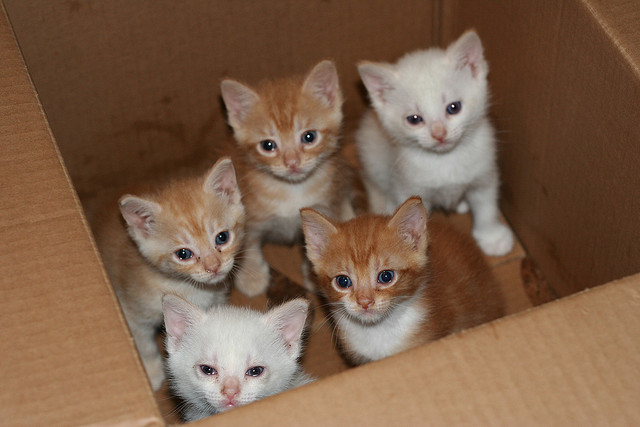
Puppy mills are still in operation in many countries, and awareness has increased as people spread the word about where the cute puppies in pet store windows really come from.
Can the same be said for kittens?
Sadly, the answer is yes.
What Is a Kitten Mill?
A kitten mill is a breeding location where purebred cats and kittens are living in tight conditions, share space with too many cats, go without medical attention and often live in their own waste.
The cats that can be bred will continue to have kittens until they are no longer able to reproduce, at which time they are killed or given away.
The animals suffer from infections, deformations, starvation and parasites, and can be the end result of inbreeding.
The health of the cats and kittens is not a concern for the kitten mill owner. The main goal is selling the kittens as soon as possible before they show signs of illness.
Money is the fuel for the fire that is irresponsible and profitable breeding, and as long as people continue to buy pets in pet stores or from breeders they do not research, mills will continue to exist.
For more information on the conditions and impact of puppy mills, check out our detailed article on What Is a Puppy Mill.
Where Are Kitten Mills Located?
Kitten mills and irresponsible backyard breeders can be down the street, in the next state, across the country, and worldwide.
There is no specific location for a kitten mill. They’re in the Midwest, California, North Carolina, and anywhere in between. The kittens end up in pet stores or are sold and shipped via the internet to anyone willing to pay the breeder’s fee.
Consider the case of Sandra Norman in North Carolina. She was reportedly breeding purebred cats in a single room in her home. The 18 cats and kittens lived together in their own feces and urine, and the smell of ammonia was so bad officials listed it as a health hazard to her children living in the home.
Neighbors were shocked, saying Norman was such a nice person.
Warning Signs of Kitten Mills
There are red flags to look out for when you visit or research a cat breeder.
Often purebred cats are advertised and sold as such, but the breeder will say that they do not come with any registration papers or health certificates.
A health guarantee, if given, will often be very short — even if the kitten becomes ill or dies, getting a refund may be impossible.
If you visit the facility, look for and ask:
- Are the cats and kittens healthy and happy?
- Do they have enough room to move around?
- Do they have clean food and water?
- Are they injured, walking with a limp, missing eyes or extremities?
- Is there an overwhelming odor of ammonia, air fresheners or chemicals?
- Are there piles of cat hair on the floors or in corners?
- Is the fur matted?
- Are the nails overgrown?
- Are you permitted to see the parents of the kittens? If so, are they in good health?
- Does the breeder always seem to have kittens available?
- Are rare or expensive breeds being sold for suspiciously low prices?
- Are veterinary records, vaccinations and health/genetic test reports available?
- Can the breeder explain the breed standard and its genetic issues?
- Is the breeder willing to show documentation from a local vet or provide the vet’s name?
These are but a few questions on a very long list of red flags. Any responsible breeders will welcome these questions, answer them, and provide documentation to prove they take good care of their animals.
There are more concerns about where and how the breeder sells the kittens.
Examples of Kitten Mill Cases
Kitten mill operators are clever, deceptive and hide their atrocities well. Consider the case of a Maine Coon breeder in Michigan who advertised his cats as “award winning” (pictured at right).
Note the breeder listed the kittens as “raised underfoot” and even recommended a recognized brand of cat food. The cats are pretty, look healthy and the text is convincing, so is it really a kitten mill? The answer is yes.
In a raid on this facility, 42 cats were seized from a trailer where the ammonia-filled air was recorded at 110 degrees Fahrenheit. Most of the food and water dishes were either empty or filled with waste, officials said. Animals were infested with fleas, had infections and were said to be in poor health.

The owner of the location was on probation and restricted from owning cats because of two previous animal cruelty arrests. He got around this by allowing his girlfriend to put her name on the business. This way they could continue operating and selling the sick and neglected kittens for $350 each, according to this 2010 news report.
The case was delayed because of a short staff and is considered a low priority.
Just when it seems the story cannot get any worse, it does.
It took two years for the charges to be filed against the man and his girlfriend. When deputies went to serve the papers at the same location, they found 32 animals in poor health.
A child was also removed by Child Protective Services because of the conditions, yet cats are still being bred at the location.
Even with evidence and pending legal charges, the current legislation is not adequate enough to stop these breeders. The cats are sold over the internet from the couple’s website. Buyers never see the conditions in which the kittens are born and raised.
An earlier case was discovered in Idaho. A woman in another state bought a 12-week-old ragdoll kitten from an Idaho breeder for $600 plus $200 for shipping. The kitten arrived sick. The woman complained to the Idaho Humane Society and Twin Falls County Sheriff’s Department — and kept complaining — until the facility was raided.
The raid resulted in the seizure of 323 cats — more than half of which (177) had to be euthanized because of poor health. During the raid officials found a locked room they called a “dead room” that housed sick animals living among the decomposing remains of dead cats.
Cats and kittens that were too sick to be sold were thrown into this room to die among the dead.
The “cat resort” owner pleaded guilty to 19 counts of animal cruelty and 51 counts of neglect. Despite a tougher penalty enacted by the Idaho legislature, animal cruelty is not considered a felony until a person has two prior convictions under the new law.
How to Stop Kitten Mills
Puppies and kittens are not the only sufferers in mills.
Any animal can be milled: ferrets, rats, guinea pigs, hedgehogs, and many more are abused and neglected in search of profits by bad breeders.
The motivation for breeders to start or continue breeding animals is money.
To stop the mills and irresponsible breeders, we need to stop the cash flow. Laws are not strict enough to prevent the cruelty, as seen in the previous examples. The best assault is education and awareness.
If people are aware that pet store animals are treated this way, they will begin to avoid those stores, research breeders, and turn to rescues and shelters. You can also:
- Urge pet stores to stop selling animals and start featuring pet adoptions.
- Report irresponsible breeders and mill operators.
- Talk to your local legislators about tougher penalties for animal abusers.
- If you’re a vet, pay attention to pet owners continuously bringing in pregnant animals.
Please continue sharing information about puppy mills and kitten mills, and remind people that dogs are not the only victims.
By spreading awareness, we can all help to decrease sales to mills and work together to shut them down while pushing for tougher legislation.
Facts About Kitten Mills
- Health Problems: Cats from kitten mills often suffer from severe health issues, including infections, worms, untreated diseases, and physical deformities due to poor living conditions and lack of veterinary care.
- Defensive Behavior: Because of minimal and often traumatic human interaction, cats from kitten mills tend to be defensive, exhibiting behaviors like biting, scratching, or hissing. They need time and patience to adjust to a more positive environment.
- Fear and Anxiety: Kitten mill cats often experience significant fear and anxiety due to their upbringing in stressful and neglectful environments. They may be particularly skittish and require gentle handling to become comfortable around humans.
- Lack of Training: These cats usually lack basic training, such as using a litter box or being groomed, because they have been confined to cages without proper care or socialization.
- Widespread Issues: Kitten mills are not confined to a specific region and can be found across various states, often hidden in unsuspecting locations. They contribute significantly to the overpopulation and suffering of cats.
- Legislative Efforts: There are ongoing legislative efforts to combat the cruelty of kitten mills, including pet store disclosure bills, pet lemon laws, and bans on the sale of animals in public places. These measures aim to reduce the profitability of mills and increase the transparency of pet sales.
Frequently Asked Questions (FAQ)
What are kitten mills?
Kitten mills are breeding facilities where cats are kept in poor conditions to produce as many kittens as possible for profit, often neglecting their health and well-being.
How to spot a kitten mill?
To stop kitten mills, avoid buying pets from pet stores or unverified breeders, support animal welfare legislation, and promote pet adoption from shelters and rescue organizations.
What are red flags for kitten mills?
Red flags for kitten mills include unhealthy or malnourished animals, breeders who always have kittens available, poor living conditions, and lack of transparency about the breeding practices and the health of the animals.



